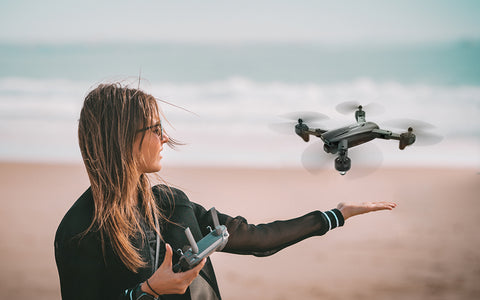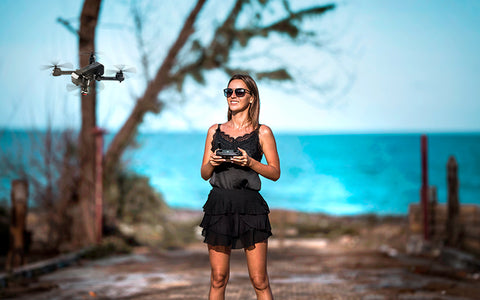Your Cart is Empty
FREE Shipping in US.
More and more people are looking to buy drones. After all, nothing better than making beautiful images of landscapes seen from above. As a result, numerous drones have appeared on the market, from mini drones to professional drones. However, as there are several models available on the market, it is necessary to know the kind of drone you are choosing.
Among the best drones on the market, we have a brand such as Snaptain. They are recognized for producing resistant and high-quality drones. That's because they invest in a lot of technology to produce devices that have high-resolution images and storage capacity. In addition, these devices have a good evaluation of the public. After all, the people who bought the drones of this brand have made positive recommendations.
So, if you are planning to buy a drone, you will want to know how it works. As a beginner, of course, it will not be easy to fly at first. But after practicing it a few times, you will get used to it. Most importantly, don't be afraid to start. Learn the preparation first, and don't be afraid of making mistakes. Want to know more? Read on!
What is a drone?

A drone is a term to refer to Unmanned Aerial Vehicles (UAVs), which do not require pilots on board to be guided. These aircraft are controlled remotely by electronic and computational means, under the supervision of humans.
They are equipped to withstand heavy work and hostile environments, and that is why they have become very common among photographers, military, delivery companies, etc.
How does a drone work?
Drones are generally very light. Most of the composition is carbon fiber, with some structures made of plastic and metal.
They are guided by remote control or automatically by computer. The controllers can be levers, smartphones, or tablets and allow for takeoff, operation, and landing.
Small electric motors rotate the propellers that support the device, a principle much like helicopters. Drones have a removable battery that provides, on average, 10 minutes of flight time.
Many manufacturers sell extra batteries, making it possible to get up to 25 minutes of flight time. However, a more powerful battery means more weight for the drone.
Controllers communicate with the drone via radio waves or via Wi-Fi. In the fuselage of the device, there is a microcontroller "brain" that contains the navigation and control systems. In this circuit, there is usually a GPS chip, which allows for precise navigation and freer flight. Using satellite location positions, it is possible to plot a path for the drone in advance.
On the same board, there is a sensor that receives the navigation instructions and transmits them to the engines, increasing or decreasing the propeller acceleration and the altitude.
Drones are programmed to land slowly, as a quick landing can lead to a crash, just as with helicopters.
Flight control steps
One of the first things you'll find in a drone box is a transmitter. Knowing what the different buttons and sticks look like is the key to being able to fly a drone. In this section, we'll focus on the functions of the left and right sticks. Depending on the model used, the remote controls may have many buttons for different functions.
The left stick (Yaw/Throttle)
While yawing is easy enough to steer the drone clockwise or counterclockwise, it will take time and experience to get used to the directional changes that occur during it.
Right Stick (Roll/Pitch)
Drone flight control for beginners: step by step guide

Now that you have learned the basic drone control commands, let's see how you can use this knowledge. This step-by-step guide will guide you through your chosen model.
Step 1: First of all, read the instructions
The first thing you should do is carefully read the instructions that come with the drone. The manufacturer is obliged to describe all the nuances that you need to know about the functions of the drone. Do not take this point too lightly. It can be useful if something happens to the drone.
Step 2: Flight location
Make sure that the location chosen for training is safe. Install the quadcopter according to the user manual. You need to understand where the front and back of the model are. Stand with the drone in front of you before flying.
Step 3: Switching on the transmitter
Do you remember that the left stick is responsible for controlling the throttle? Power on the transmitter while holding down the throttle stick. Holding down the throttle protects the drone from suddenly flying in case there is an error on your transmitter.
Step 4: Takeoff and landing
Now it's time to fly your drone. The first maneuver you will perform is takeoff and landing. Start by moving the left stick (throttle) up for the drone to take off. If the drone begins to tilt forward or backward, it is necessary to adjust the pitch (right stick up and down). The same is true for the balance control (right stick left and right). If you see the drone tilting on all axes, adjust and maintain balance.
After taking off and adjusting the drone, try to land as softly as possible. This is done by moving the left stick down. Try to land at the same spot where you started your flight.
Step 5: Takeoff and altitude hold
The next step to fly your drone is to take off and hold the drone a couple of meters above the landing point. Keep the drone level and as still as possible over the takeoff point. This step requires a lot of concentration for it to be successful. It may seem difficult at first, but once you master this technique, you will understand how to properly take off and land. It also helps you become a safe "pilot" and guarantees you a long life for your device.
If you do not practice these basic maneuvers - takeoff, landing, and balancing, you will have a hard time with more complex tricks.
Step 6: Rotate the drone.
One of the most important things in flying a quadcopter is learning how to turn it correctly. Yaw is responsible for the rotation of your drone. Let's complicate our lessons a little. You have to take off and turn your drone to face where you are standing.
Step 7: Combine drone controls.
We have come to what you must learn to become an experienced pilot. It's time to combine your lessons into a single sequence. After launching the quad, try moving it back and forth (so far, we have only used these commands to maintain balance in the air). Now you don't need to yaw. Just fly back and forth a few times to get an idea of how fast your drone is.
Do the same with balancing. Fly your drone from left to right and back again, keeping the same altitude and orientation. These are the first two commands to be combined. Try moving the drone forward and to the left to see if you can do it at the same time. Then repeat all steps and combinations on the right stick.
Fly tips for drones
Whoever owns a drone certainly lives in a world of fun. Flying with drones is a cool hobby. But remember, there is no secret. It is practical. The more hours of flight, the more skillful you become. Check out important tips on how to fly a drone safely.
The first thing you should do is get to know your drone well. Observe how it is assembled and how it works. Learn all about the controls, settings and find out how long the battery is. All this and much more you will find in the instruction manual of the device.
There are a few things you should do before you put your drone up in the air. Most drones usually have a battery that revolves around 10 to 15 minutes. With that, the idea is to make the flight very objective. You can set aside time to plan your flight and save hours of flights and battery charge just by planning.
Choose well the place where you intend to practice your first flights. Prefer open places, like parks and soccer fields, where there is not a lot of movement of cars, people and planes.
While learning to fly with your drone, keep it away from trees, buildings, poles, and power lines. In addition, do not use your drone near barracks, prisons, police stations, and airports, as you may be penalized. Flight in these areas is strictly prohibited.
Always consult applications that show the weather. Depending on the conditions, your drone may suffer damage and even fall in case of very strong gusts, among other climatic conditions.
When flying, keep your eyes on the drone and stay focused without distractions. Be aware of the application that will indicate the battery, obstacles, and even any situation that you consider abnormal. In the latter case, the experience of flying is always welcome, as it is possible to detect possible imminent risks in advance.
Conclusion
As with all learning, the beginning is usually difficult, and surely you will take several trips with an obstacle such as walls and trees, or your drone will be caught by a gust of wind that will make it fall. But in the end, practice makes perfect. Make use you get the best quality drone from Snaptain and notice how everything will go better.
Bonjour
J’ai essayé le A15F sans utiliser mon smartphone, j’ai appuyé sur le bouton caméra , est-ce que des images sont enregistrées et comment les récupérer?

Pin
January 09, 2022
Reçu en cadeau pour un jeune ado, il faut de l’entraînement mais facile à comprendre . Bel objet !